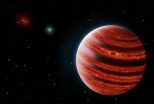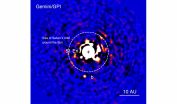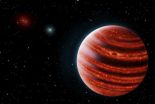(Press-News.org) The Gemini Planet Imager has discovered and photographed its first planet, a methane-enshrouded gas giant much like Jupiter that may hold the key to understanding how large planets form in the swirling accretion disks around stars.
The GPI instrument, which is mounted on the 8-meter Gemini South telescope in Chile, is the size of a small car and was designed, built and optimized for imaging and analyzing the atmospheres of faint Jupiter-like planets next to bright stars, thanks to a device that masks the star's glare.
In December 2104, GPI began searching hundreds of nearby young stars, and after a mere month, University of California, Berkeley, postdoctoral fellow Robert De Rosa began looking at the initial data. He soon noticed something large orbiting a young star in a triple-star system only 100 light years from Earth. He and graduate student Jason Wang summoned the GPI team, which confirmed the planet.
The planet, dubbed 51 Eridani b, is a million times fainter than its star, 51 Eridani, and shows the strongest methane signature ever detected on an alien planet, which should yield clues as to how the planet formed. The planetary system is very young - around 20 million years old, compared to our own 4.5 billion-year-old solar system - and provides a view of what Jupiter might have looked like in its infancy.
"This is exactly the kind of planet we envisioned discovering when we designed GPI," said James Graham, a UC Berkeley professor of astronomy and the GPI project scientist. "We wanted to find planets when they're young so we can figure out the formation process."
The planet is estimated to be about twice the mass of Jupiter, and orbits at a distance of 13 AU, or slightly farther from its star than Saturn is from the sun. An AU is equal to the Earth-sun distance, or 150 million kilometers (93 million miles). Two of the stars in the system form a close pair far from the planet's host star, and apparently do not affect the planet's orbit.
Spectra of the planet reveal methane gas as well as water similar to the conditions thought to occur deep in Jupiter's atmosphere..
"Judging by its low luminosity, low temperature and strong methane signature, this is the most Jupiter-like exoplanet ever directly imaged," said Graham,
"Many of the exoplanets astronomers have studied before have atmospheres that look like very cool stars," said Bruce Macintosh, a professor of physics in the Kavli Institute at Stanford University who led the construction of GPI and now leads the survey. "This one looks like a planet."
Graham, Macintosh, De Rosa, Wang and their team members will publish their results online Aug. 13 in Science Express.
Hot start vs cold start
Astronomers believe that the gas giants in our solar system formed by building up a large rocky core over a few million years and then pulling in a huge amount of hydrogen and other gasses to form an atmosphere. But the gas-giants exoplanets discovered by direct imaging that have so far been discovered are hot, hinting that they formed much faster as material collapsed rapidly to make a very hot planet, so called "hot-start" scenario. The cold-start scenario, called core accretion, can also form rocky planets like Earth and Mars, but the hot-start model of gravitational collapse might only make giant gas planets.
The low temperature of 51 Eridani b, estimated to be about 430 Celsius (800 Fahrenheit), may mean that this is the first example of a directly imaged planet that is consistent with a cold-start formation mechanism, the team concluded.
"51 Eri b is the first one that's cold enough and close enough to the star that it could have indeed formed right where it is the 'old-fashioned way,'" Macintosh said. "This planet really could have formed the same way Jupiter did - this whole planetary system could be a lot like ours."
There are hundreds of planets a little bigger than Earth out there, Macintosh said, but there is so far no way to know if they are really "super-Earths" or just micro-sized gas and ice planets like Neptune or something different all together. Using GPI to study more young solar systems such as 51 Eridani, he said, will help astronomers understand the formation of our neighbor planets, and how common that planet-forming mechanism is throughout the universe.
"Our knowledge today of how planets form reminds me of our knowledge 50-60 years ago of how stars form," Graham said.
Direct imaging
Fewer than a handful of exoplanets have been imaged, but even without an image, astronomers have found ways to study their atmospheres. When a planet passes in front of its star - a so-called transit - some of the star's light is blocked or absorbed, yielding a spectral signature of the chemicals in the atmosphere. The frequencies (wavelengths or colors) of light reflected by a planet can provide similar information.
But those techniques sample only a thin layer of material at the very top of the atmosphere, Graham said. GPI detects light emitted directly by planets, rather than light reflected or transmitted through the atmosphere. This light is from the heat remaining after gravitational collapse of gas and dust that formed the planet. When we look at Jupiter, half the light we see, primarily in the infrared, comes from internal heat remaining after its collapse into a planet 4.5 billion years ago.
The new planet is so young that nearly all the observed light comes from inside, allowing astronomers to sample the chemical structure in different atmospheric layers.
The team plans to begin observing the planet again in late September, when it emerges from behind the sun, and hope to find that the planet has moved along its orbit: confirmation that it is, in fact, a planet.
INFORMATION:
Other UC Berkeley authors of the paper are graduate student Tushar Mittal; undergraduate Maissa Salama; astronomy professors Paul Kalas, Stephen Beckwith and Eugene Chiang; research astronomer Gaspard Duchene; and postdoctoral fellows Rebekah Dawson and Robin Dong.
A Jupiter-like planet within a young system that could serve as a decoder ring for understanding how planets formed around our Sun has been discovered by a team of astronomers from the University of Montreal's Institute of Research on Exoplanets (iREx) in collaboration with an international team of astronomers led by professor Bruce MacInstosh from Stanford University. One of the best ways to learn how our solar system evolved is in fact to look to younger star systems in the early stages of development.
The new planet, called 51 Eridani b, is the first exoplanet discovered ...
While it may not shock you to learn that children born with disorders of sex development (DSD) face challenges, Concordia University researchers have confirmed that these go far beyond the physical.
In a paper published in the journal Hormone and Metabolic Research, psychology professor William M. Bukowski and his co-authors Elizabeth McCauley and Thomas Mazur examine the potential effects that these disorders can have on children's and adolescents' peer relationships.
The term "disorders of sex development" covers a range of conditions, from physical malformations ...
Fifteen years ago, an odd mutant fruit fly caught the attention and curiosity of Dr. Ravi Allada, a circadian rhythms expert at Northwestern University, leading the neuroscientist to recently discover how an animal's biological clock wakes it up in the morning and puts it to sleep at night.
The clock's mechanism, it turns out, is much like a light switch. In a study of brain circadian neurons that govern the daily sleep-wake cycle's timing, Allada and his research team found that high sodium channel activity in these neurons during the day turn the cells on and ultimately ...
For any complex society to function properly, individuals--be they people or social insects--must reliably recognize their friends and family with whom they live and work and readily distinguish those allies from strangers. Ants and other social insects manage this feat of recognition based on chemical pheromones, which are detected via sensors in their antennae. Now researchers reporting August 13 in Cell Reports have discovered that when it comes to assessing body odors, ants really don't miss a thing.
"To our surprise, these very low volatility compounds are not only ...
A link between malaria and Burkitt's lymphoma was first described more than 50 years ago, but how a parasitic infection could turn immune cells cancerous has remained a mystery. Now, in the August 13 issue of Cell, researchers demonstrate in mice that B cell DNA becomes vulnerable to cancer-causing mutations during prolonged combat against the malaria-causing Plasmodium falciparum.
Individuals who are chronically infected with certain pathogens are at increased risk of developing lymphomas, cancers of the antibody-producing B lymphocytes. For example, Burkitt's lymphoma, ...
A study from the US National Institutes of Health presents some of the most precise human data yet on whether cutting carbs or fat has the most benefits for losing body fat. In a paper published August 13 in Cell Metabolism, the researchers show how, contrary to popular claims, restricting dietary fat can lead to greater body fat loss than carb restriction, even though a low-carb diet reduces insulin and increases fat burning.
Since 2003, Kevin Hall, PhD--a physicist turned metabolism researcher at the National Institute of Diabetes and Digestive and Kidney Diseases--has ...
Irisin, a hormone linked to the positive benefits of exercise, was recently questioned to exist in humans. Two recent studies pointed to possible flaws in the methods used to identify irisin, with commercially available antibodies. In Cell Metabolism on August 13, the Harvard scientists who discovered irisin address this contentious issue by showing that human irisin circulates in the blood at nanogram levels and increases during exercise.
Senior study author Bruce Spiegelman of Dana-Farber Cancer Institute and Harvard Medical School says that the confusion over irisin ...
The mechanisms that allow the liver to repair and regenerate itself have long been a matter of debate. Now researchers at University of California, San Diego School of Medicine have discovered a population of liver cells that are better at regenerating liver tissue than ordinary liver cells, or hepatocytes. The study, published August 13 in Cell, is the first to identify these so-called "hybrid hepatocytes," and show that they are able to regenerate liver tissue without giving rise to cancer. While most of the work described in the study was done in mouse models, the researchers ...
In what appears to be an unexpected challenge to a long-accepted fact of biology, Johns Hopkins researchers say they have found that ribosomes -- the molecular machines in all cells that build proteins -- can sometimes do so even within the so-called untranslated regions of the ribbons of genetic material known as messenger RNA (mRNA).
"This is an exciting find that generates a whole new set of questions for researchers," says Rachel Green, Ph.D., a Howard Hughes Medical Institute investigator and professor of molecular biology and genetics at the Johns Hopkins University ...
Researchers from the National Institute of Allergy and Infectious Diseases (NIAID), part of the National Institutes of Health, and their collaborators have developed an experimental, nanoparticle-based vaccine against Epstein-Barr virus (EBV) that can induce potent neutralizing antibodies in vaccinated mice and nonhuman primates. Microscopic particles, known as nanoparticles, are being investigated as potential delivery vehicles for vaccines. The scientists' findings suggest that using a structure-based vaccine design and self-assembling nanoparticles to deliver a viral ...





